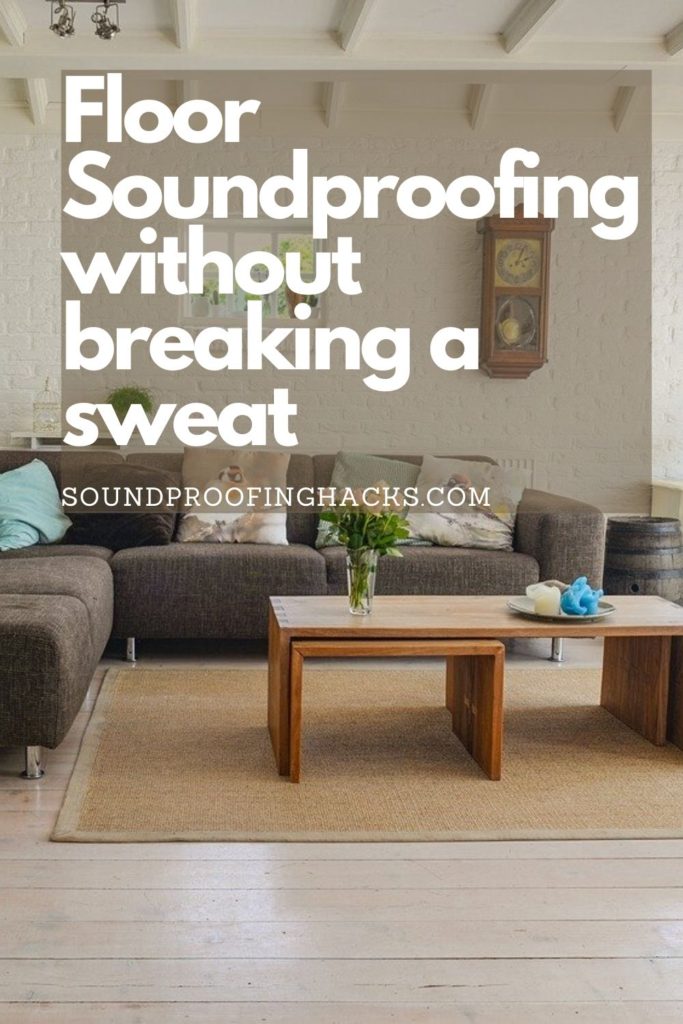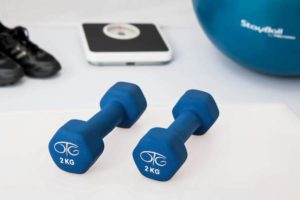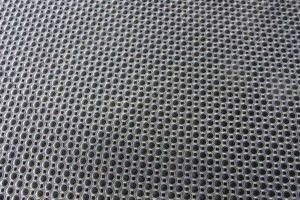Floor Soundproofing in 5 Easy Steps!
If you’re looking to give your home a soundproofing treatment, then there’s no better place to start with than the floors. This guide will show how to do just that in quick, easy steps that won’t unnecessarily break the bank, either.

Living an apartment can be a noisy affair with loud sounds coming from all directions at any time of the day. This is especially true for those who live in urban environments where it can sometimes be impossible to escape the ruckus of the city or rambunctious occupants in the vicinity. Perhaps you’re the noisy neighbor with a household full of young children who frequently stampede across the house, probably irritating your downstairs neighbor to no end.
Whether you want to soundproof your floors out of necessity or simply to improve the quality of your home, there are plenty of cheap yet effective methods to soundproof an apartment floor. These don’t necessarily require any construction either, meaning you won’t have to worry about losing your security deposit to your landlord if the time ever comes to move. Look no further for a comprehensive guide on how to soundproof the floors of your apartment without even breaking a sweat.
I am an Amazon Affiliate, which means I may make a commission if you purchase something through the links here. There is NO extra cost to you at all, and THANK YOU so much for the support.
Related: Insanely easy ways to soundproof a baby room
Why soundproof your floors?
Floors can be some of the biggest sources of noise in a home, often experiencing impact noises when items are dropped on them or transmitting everything from blaring music toarguments from below.
 Electing to soundproof the ones in your home will yield a significant change in the noise level reduction both from within your home and from your downstairs neighbor’s domicile.
Electing to soundproof the ones in your home will yield a significant change in the noise level reduction both from within your home and from your downstairs neighbor’s domicile.
This includes absorbing any airborne sounds and vibrations produced in your daily life like exercising in your home gym or playing with your children.
The advantages are endless, particularly when compared to the relative ease of installing acoustical materials specially made for floors.
You’ll be able to go back to tap-dancing at dawn without a lick of guilt in no time at all.
Related: Cheapest ways to soundproof a basement ceiling
How can you benefit from floor soundproofing?
Anyone who lives in an apartment can benefit from soundproofing the floors in their home since it provides a variety of perks from better noise isolation to improved acoustics.
For those craving to turn their home into a safe haven, soundproofing your floor is a great way to regain some semblance of peace in an increasingly deafening world.
Noise pollution has been proven to decrease productivity and constant fracases can have a detrimental effect on someone’s mental health.
Soundproofing your flooring will help to reduce the amount of distractive bedlam that travels through the surfaces below you and directly into your apartment.
Still, perhaps it’s you who is the culprit of all the noise and you wish to greatly insulate your home from what lies beneath it.
Maybe you’ve come to realize that while the pitter-patter of your tots’ or pets’ tiny feet might be music to your ears, it’s most likely a recurring disturbance to the neighbors underneath you.
It’s good to remember that they can probably hear you just as much as you hear them and there’s nothing ever wrong with trying to be a more considerate neighbor.

Maybe you really want to preserve your privacy so you can blast your television at high volume without receiving noise complaints from the people who stay below your apartment. Soundproofing the floor will prevent sounds from funneling down just as much as it prevents them from channeling up.
Even people who live in multi-level, penthouse apartments can take advantage of the benefits offered by investing in soundproofed flooring.
You could stop interruptions from coming up from your children’s playroom right into your home office or prevent late-night disruptions from floating from the living room to your bedroom when you’re trying to get some quality sleep.
Energy-conscious individuals will also get an extra kick out of soundproofing their floors since sound-dampening materials typically also act as thermal insulators, trapping in heat or cold.
This means using less heating in the wintertime and less air-conditioning in warmer months as the materials will slow the transfer of heat between surfaces, which is sure to save you on your electricity bill.
Soundproofing your floors is sure to limit the noise and heat transmission between your home and the next, or even within your home, to create a more tranquil, comfy household.
The differences in sound reduction and temperature regulation will be easily noticeable. Say so long to icy, winter floors.
Related: How to make your own DIY sound panels
How it works and steps for floor soundproofing
In residential buildings, sound tends totravel in two ways: through airborne noise or impact noise.
Airborne noise is generated when an object emits or produces sound waves which then journey through the air, often coming into contact with solid surfaces.
This contact turns the sound waves into vibrations which can consequently radiate out even further. This is generally how noise works when it wafts up from your neighbor’s home to yours in the form of music or a loud conversation.
The other type of noise, impact noise, is sometimes called structure-borne noise and is caused by an object coming into physical contact with a solid surface, propagating sound waves such as vibrations.
This can happen when you accidentally drop something to the ground or even when you walk across the threshold too quickly. Your footsteps and other such noises can easily reverberate down into your neighbor’s home, drawing ire and resentment over a prolonged period of time.
Soundproofing your floor will help to reduce the noise transmission in your apartment from both inside and outside, dampening both airborne and impact noises.
There are a few ways to accomplish this but the most economic and time-saving methods are listed below from the most affordable and least complicated to pricier techniques which might require a bit of elbow grease.
If you’re renting your apartment, as always, it’s imperative to get explicit permission from the owner before undertaking any home improvement project, lest you violate the terms of your lease.
Most of these techniques are non-invasive, however, and won’t leave noticeable traces should you decide to remove them.
Related: Best Quiet Coffee Grinders
1. Place carpets and rugs
Since most floors in an apartment are made up of hard materials like wood, tile or linoleum, placing a soft, dense rug or carpet on top of them helps to absorb a lot of noise.
Ideally, you should cover as much of your flooring as possible in a thick carpet or several rugs as they can deter sound from passing through them.
The more tightly-woven the material, the better it will perform at reducing both airborne and impact noises within your home.
2. Invest in cork or foam tiles
If shaggy carpets and rugs just aren’t your style, then perhaps cork or foam tiles can be a better option for you. Like carpets, they can be set up on top of already existing flooring and locked into place together, often coming in a plethora of styles.
Cork tiles will better work to add density to your floor than foam tiles, which ultimately helps to reduce sound transmissions. Cork tiles are also a great option for people with bad knees or other joint problems as they provide some cushion, unlike other hard floorings.
The tiles can additionally be placed beneath carpets for better noise absorption.
3. Lay down rubber floor mats
Similar to carpets and cork tiles, floor mats are a non-costly way to soundproof your floors. Mats might even be more effective than some woven materials as they lack holes which could lead to sounds leaking through them.
Rubber versions are becoming increasingly common in modern homes for their ability to provide thermal insulation as well as noise-cancellation. They’re one of the easiest solutions to soundproofing a floor, usually come in interlocking sets and are often cheaper than rugs or cork tiles.

Plus they now come in a myriad of colors, at least one of which is bound to compliment your home decor, all while being shock-resistant and anti-slip.
This makes them even better suited for those who are looking to reduce falls from slipping, as is prone to happen on smoother surfaces.
4. Install acoustic floor underlayment
Mass loaded vinyl (MLV) is another excellent thermal insulator that can fit perfectly beneath carpets, floor mats, and cork tiles. MLV is a highly-dense vinyl sheeting that is sometimes embedded with metal pieces yet still remains very flexible. It can be used in conjunction with any combination of other soundproofing materials in the place of acoustic floor underlayment.
Again, like with the underlayment, MLV can be installed in one of two ways.
The first is the most convenient which entails placing the MLV on top of already existing flooring, nailing it in place to the floor and covering it with another dense material like carpeting.
The second method requires removing the old flooring to expose the subfloor and gluing the MLV there with Green Glue Compound before laying the new flooring.
This latter option is only possible if green-lit by the homeowner, however.
5. Splurge on some mass loaded vinyl
Mass loaded vinyl (MLV) is another excellent thermal insulator that can fit perfectly beneath carpets, floor mats, and cork tiles. MLV is a highly-dense vinyl sheeting that is sometimes embedded with metal pieces yet still remains very flexible. It can be used in conjunction with any combination of other soundproofing materials in the place of acoustic floor underlayment.
Again, like with the underlayment, MLV can be installed in one of two ways.
The first is the most convenient which entails placing the MLV on top of already existing flooring, nailing it in place to the floor and covering it with another dense material like carpeting.
The second method requires removing the old flooring to expose the subfloor and gluing the MLV there with Green Glue Compound before laying the new flooring. This latter option is only possible if green-lit by the homeowner, however.
Additional tips
It’s important to carefully measure the dimensions of the floor you want to soundproof in order to determine how much material you’ll need to complete the job. If the room is very large, then it might be best to place the materials in sections rather than as solid pieces since this will allow for more flexibility while installing.
A combination of materials will also work better at reducing noise transmissions so interested parties should look to invest in at least two of the methods mentioned so far. This can’t be done in any order, however, with a mixture between dense materials and woven materials being ideal. The most convenient arrangement would be to place thin rubber mats on your existing flooring and then cover them with a thick carpet made of tightly-woven fabrics, which is a process that requires no tools or construction.

The most effective method, however, does need a bit of construction as it involves removing the original flooring to gain access to the subfloor. MLV or acoustic floor underlayment can be attached using nails or, more effectually, using Green Glue Compound, which is a great soundproofing agent when combined with other sound-deadening materials.
Make sure not to leave any gaps from the materials on the floor as this will significantly reduce their sound-reduction properties since gaps let noises leak through. The best deterrent for noise pollution is continuous, multiple layers because density improves acoustical and thermal insulation.
Finally, try to maintain the quality of your new flooring or acoustic materials so that they’ll last for as long as possible. The last thing you’ll want is to shell out a bunch of cash only to have to replace everything within a couple of years. Preservation will be key to retaining the durability of what rests underneath your feet.
Recommended Gear
Soft Modern Large Shaggy Rug
- What I Like
- Available in various colors and sizes
- Hypoallergenic
- Non-toxic
- Machine-washable
- Easy to clean
- Dishwasher-safe
- What I Don’t Like
- Not machine-dryable
- Can be slippery
Forest Floor Interlocking Foam Tiles
- What I Like
- Available in various colors and styles
- Can substitute as exercise mats
- Easy to assemble
- Cushioned for joint support
- Child-friendly
- Shock absorbent
- What I Don’t Like
- Only for indoor use
- Must be used on hard, flat surfaces
- Not suitable for use over carpets
- May become indented under heavy furnishings
- Tends to bubble when exposed to direct sunlight
Rub-Cal Recycled Floor Mat
- What I Like
- Available in a wide selection of sizes
- Wear-resistant
- Made from 100% recycled rubber
- Can be used outdoors
- Anti-slip
- Shock absorbent
- What I Don’t Like
- Pricey
- Tends to attract dust and dirt
Roberts Floor Underlayment
- What I Like
- Available in a wide selection of sizes
- Wear-resistant
- Made from 100% recycled rubber
- Can be used outdoors
- Anti-slip
- Shock absorbent
- What I Don’t Like
- Pricey
- Tends to attract dust and dirt
QuietWalk Floor Underlayment
- What I Like
- Ideal for use over concrete or wood subfloors
- Has moisture-resistant vapor barrier
- Great thermal insulator
- What I Don’t Like
- Pricey
- Should not be nailed down
Bare Decor Solid Teak Wood Interlocking Floor Tiles
- What I Like
- Can be used over uneven flooring
- Can be used outdoors
- Easy to assemble
- Conveniently removable
- Teak wood is from Indonesia
- What I Don’t Like
- Has gaps between wood slats
- Color might fade when exposed to nature
TotalMass Mass Loaded Vinyl
- What I Like
- Can be used over any hard surface
- Available in various weights
- Seams can be held in place with duct tape
- Can be used outdoors
- What I Don’t Like
- Pricey
- Heaviness makes it difficult to install alone
Trademark Soundproofing Green Glue Compound
- What I Like
- Can be painted over
- Good for added sound-dampening between layers
- What I Don’t Like
- Can be difficult to use
Clevr Interlocking Foam Tiles
- What I Like
- Available in various colors
- Water-resistant
- Shock absorbent
- Easy to assemble
- Comes with 1-year warranty
- What I Don’t Like
- Can be slippery
- Must be used on hard, flat surfaces
- May become indented under heavy furnishings
Sorbus Wood Grain Floor Mats
- What I Like
- Available in various colors
- Easy to assemble
- Waterproof
- Child-friendly
- Affordable
- What I Don’t Like
- Can on be used indoors
- Must be used on hard, flat surfaces
- Backside can be slippery
Frequently Asked Questions (FAQ)
How can I soundproof my floor cheaply?
The cheapest way to soundproof a floor is by placing rubber floor mats or even some thick carpeting.
What’s the best soundproofing material for floors?
The best material would be a combination of mass loaded vinyl along with acoustic floor underlayment and a dense carpet to really stop sound from traveling between surfaces.
How can I reduce noise from upstairs?
If you have access to the room above you, soundproofing the floor will keep noise from echoing downward. If not, then soundproofing the ceiling with acoustic panels is another option.
How do you soundproof a noisy neighbor?
If they’re your downstairs neighbor, try soundproofing the floor. If they live upstairs, soundproof the ceiling. If they reside next door to you, it’s also possible to soundproof your walls to prevent their noise from coming into your home.
Related: Does soundproof wallpaper work?
Floor Soundproofing: Conclusion
No matter how you decide to soundproof the floor of your apartment, as long as you used one of the methods suggested on this list, it’s sure to help ease your problems with noise pollution from below.
This will undoubtedly bring more peace to your home, allowing for a calmer, saner living experience. So what are you waiting for?
That serenity could be yours today.
Additional Reading:
- Latest articles on Soundproofing Hacks
- Soundskins vs Dynamat: Battle of the sound deadeners
- Insanely easy ways to soundproof a baby room
- How to make a soundproof box? 10 Simple steps that work
- How to soundproof your bathroom: A private place
- How to make air conditioner quieter? 6 simple tips that work!
- All Buying Guides










